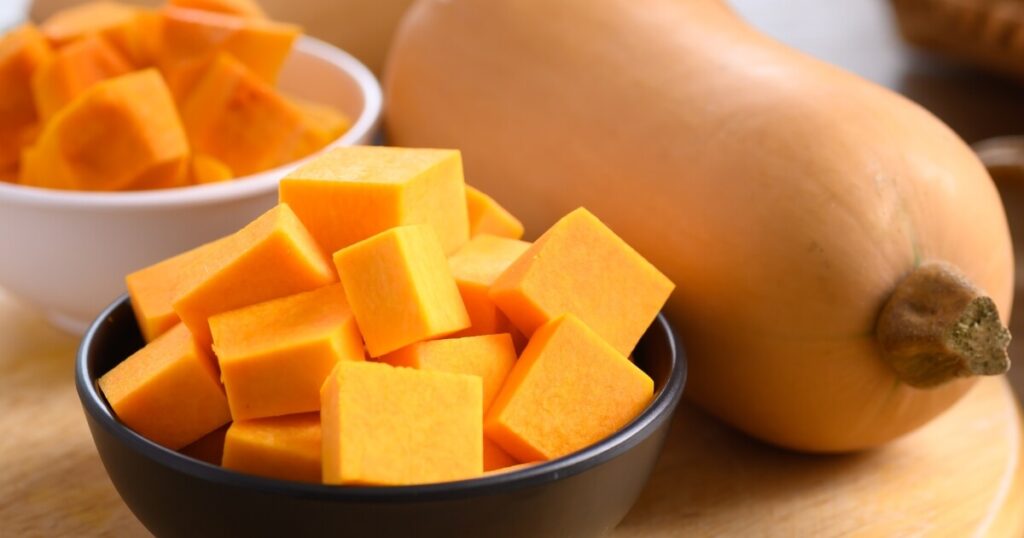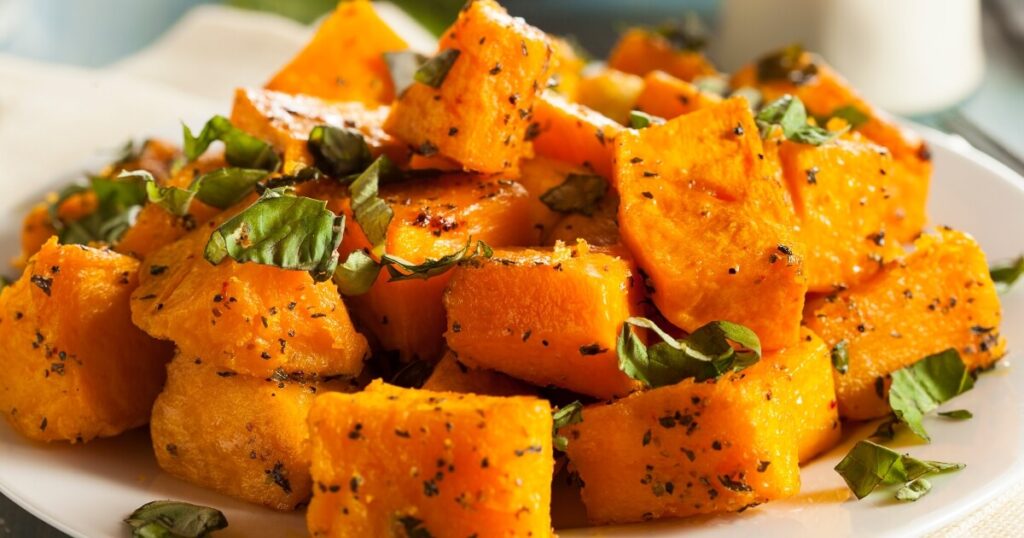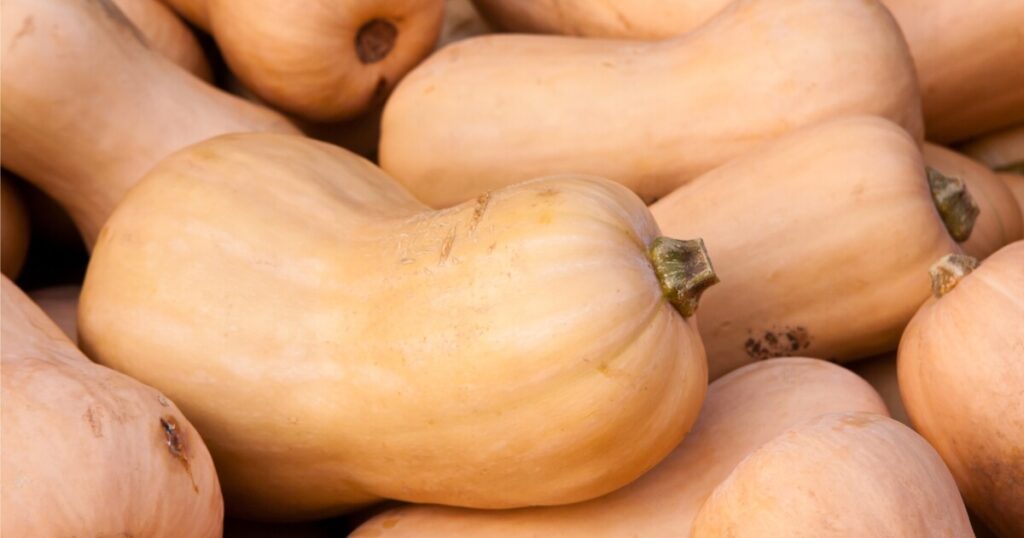Butternut squash is often found in comforting soups and creamy risottos to hearty salads and pasta dishes. But what does it taste like?
Butternut squash tastes slightly sweet and has a mild nutty flavor. It reminds me of a sweet potato but with a hint of earthiness that gives it a distinct character. The soft yet firm texture complements its taste, making every bite a pleasure.
How Does Butternut Squash Taste?

Here’s a detailed look at what you can expect when you take a bite:
The primary flavor of butternut squash is a mild sweetness, often compared to a sweet potato’s. It also has a subtle nuttiness, which adds depth and complexity to its overall flavor profile.
When cooked, butternut squash has a soft and creamy texture. It’s similar to a roasted sweet potato but tends to be a bit softer. The flesh of the squash becomes tender and smooth, making it a pleasure to eat.
The aroma of butternut squash is slightly sweet and earthy. When cooked, especially when roasted, it releases a warm, comforting aroma that fills your kitchen and makes your mouth water.
One of the great things about butternut squash is its versatility. Its mild and slightly sweet flavor allows it to blend well with various other ingredients.
It can be seasoned with aromatic herbs and spices like cinnamon, nutmeg, or rosemary or paired with savory ingredients like garlic and onion.
Remember, the taste of butternut squash can vary slightly depending on how it’s cooked. Roasting brings out its natural sweetness while boiling or steaming might produce a more subdued flavor.
Does Butternut Squash Taste Good?

The taste of butternut squash is generally well-liked due to its sweet, nutty flavor and creamy texture. However, like any food, whether it tastes good or not can be subjective and depends on personal preference.
Common Complaints and Misconceptions
Some people might find butternut squash too sweet for their liking, especially when it’s cooked through methods like roasting that enhance its natural sweetness.
Others might not be fond of its soft texture when cooked. There’s also a misconception that butternut squash is bland, but this is usually because it hasn’t been properly seasoned. With the right spices and herbs, butternut squash can be a flavorful addition to your meals.
Why It Might Taste Bad
If you find butternut squash tasting bad, it could be due to a few reasons. It might not be ripe enough, resulting in a less sweet and somewhat starchy flavor.
Overcooking can also make the texture mushy and unappealing. Additionally, if it’s not seasoned well, it can taste bland.
Fresh vs. Frozen
Fresh butternut squash usually has the best flavor and texture. When it’s fresh, it’s sweet, nutty, and has a nice firmness that softens when cooked.
Frozen butternut squash, on the other hand, is a convenient option and can still taste good, but it might not have the same firmness as fresh squash once cooked. It’s best for recipes where the texture of the squash isn’t the main focus, like soups or purees.
How to Make butternut squash Taste Better
Making butternut squash taste better involves a few simple steps and techniques that can enhance its natural flavors and make it a star ingredient in your dishes:
- Choosing the Right Squash: Start by choosing a ripe butternut squash. It should have hard, beige skin without any cuts or bruises. Ripe squash will have a sweet, nutty flavor that’s more pronounced than an unripe one.
- Proper Cooking Methods: Roasting butternut squash is one of the best ways to bring out its sweetness. Cut the squash into cubes, toss it with some olive oil, salt, and pepper, and roast in the oven until it’s tender and slightly caramelized.
- Seasoning: Don’t be shy with seasonings. Salt and pepper are necessary, but add other spices and herbs to complement the squash’s sweetness. Cinnamon, nutmeg, and sage work well. For a savory twist, try garlic, rosemary, or thyme.
- Pairing with Complementary Flavors: Butternut squash pairs well with a variety of flavors. Try pairing it with apples, cranberries, or pecans for a sweet dish. For something savory, try it with onions, spinach, or bacon. Cheese, especially goat cheese or Parmesan, also pairs wonderfully with butternut squash.
Adding a Touch of Sweetness: If you want to enhance the natural sweetness of butternut squash, try basting it with a touch of maple syrup or brown sugar before roasting it.
What A Butternut Squash Looks Like

Butternut squash is quite distinctive in appearance, which makes it relatively easy to identify at the grocery store. Here’s what to look for:
Shape and Size: Butternut squash is typically bell-shaped or pear-shaped. It has a long, straight neck and a bulbous bottom. The size can vary, but most butternut squashes are about 8 to 12 inches long.
Color: The skin of butternut squash is a uniform tan or beige color. It should be matte, not shiny. The flesh inside is a vibrant orange.
Skin Texture: The skin of the butternut squash is hard and smooth. It should be free of cuts, bruises, or blemishes. Any spots or discoloration can be a sign of damage or early spoilage.
Weight: A butternut squash should feel heavy for its size. This is a good indication that it’s fresh and full of moisture.
When buying butternut squash, give it a good once-over. Check the skin for signs of mold or damage, and pick it up to feel its weight. A good butternut squash should feel solid and heavy, and the skin should be hard and free of blemishes.
Vegetables That Taste Similar To Butternut Squash
While butternut squash has a unique flavor profile, a few other vegetables have similar tastes and can be used as substitutes in recipes. Here’s how they compare:
- Sweet Potato: Sweet potatoes are often compared to butternut squash due to their similar sweet, earthy flavor. They also have a similar texture when cooked, being soft and creamy. Sweet potatoes can be a good substitute in recipes that call for roasted or mashed butternut squash.
- Pumpkin: Pumpkin has a sweet and slightly nutty flavor similar to butternut squash. It’s a bit more subtle in taste but can be used instead of butternut squash in most recipes, especially in soups and purees.
- Acorn Squash: Acorn squash is another winter squash variety that tastes somewhat similar to butternut squash. It’s less sweet and more nutty, but it has a similar texture when cooked. Acorn squash can be used as a substitute in recipes that call for butternut squash, although the final dish might be less sweet.
- Carrots: While not as similar as the other vegetables listed, carrots have a sweetness that resembles butternut squash when cooked. They can be used in soups or purees as a substitute for butternut squash.
Remember, while these vegetables have similar flavors, they each bring their own unique qualities to a dish.
Recipes and Side Dishes with Butternut Squash
Here are some popular recipes and side dishes where butternut squash shines:
Butternut Squash Soup: This is perhaps one of the most popular dishes made with butternut squash. The squash is roasted or boiled until soft, then blended with onions, garlic, and broth to create a flavorful soup. Some recipes also add spices like nutmeg and cinnamon for extra warmth.
Roasted Butternut Squash: Simple yet delicious, roasted butternut squash is a great side dish that can accompany any main course. The squash is cubed, tossed with olive oil, salt, and pepper, and then roasted until it’s tender and caramelized. You can also add herbs like rosemary or thyme for additional flavor.
Butternut Squash Risotto: In this dish, the squash is cooked until soft and mixed with Arborio rice, broth, and Parmesan cheese to create a creamy, comforting risotto. The sweetness pairs well with the savory elements of the risotto.
Butternut Squash Pasta: Cubes of butternut squash can be added to pasta dishes for a sweet contrast to savory sauces. It pairs well with brown butter sauce and sage or can be mixed with spinach and goat cheese for a creamy pasta dish.
Butternut Squash Salad: Add roasted butternut squash to salads for a lighter dish. It pairs well with leafy greens, dried cranberries, pecans, and a tangy vinaigrette.
Butternut Squash FAQs
Does Butternut Squash Taste Like Sweet Potato?
Yes, butternut squash and sweet potato share a similar sweet and slightly nutty flavor profile. However, butternut squash tends to be a bit milder and creamier in texture when cooked.
Does Butternut Squash Taste Like Pumpkin?
Butternut squash and pumpkin have a similar taste, both sweet and slightly nutty flavor. However, butternut squash is often considered to be sweeter and nuttier than pumpkin.
Which Tastes Better: Butternut Squash or Pumpkin?
Butternut squash and pumpkin preference is subjective and depends on personal taste. Some people prefer the sweeter and nuttier flavor of butternut squash, while others prefer pumpkin’s subtler and earthier flavor.
What is Butternut Squash Similar To?
The flavor of butternut squash is similar to sweet potato and pumpkin. When cooked, it has a sweet, slightly nutty flavor and a creamy texture. In terms of appearance, it’s a bell-shaped vegetable with hard, beige skin and vibrant orange flesh.
How to Enhance the Taste of Butternut Squash?
The taste of butternut squash can be enhanced by proper cooking methods like roasting, seasoning it well with herbs and spices, and pairing it with complementary flavors. Adding a touch of sweetness with ingredients like maple syrup or brown sugar can also help to enhance its natural sweetness.